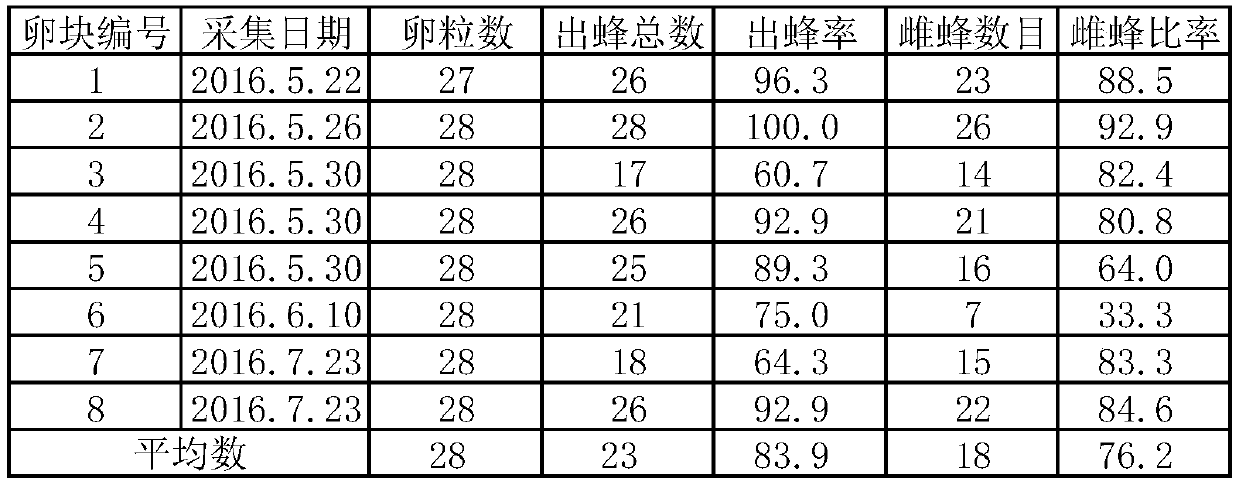A kind of artificial breeding method of tea-winged stink bug
A technology of tea-winged stink bug egg bee and artificial breeding, which is applied in animal husbandry and other fields, can solve the problems that natural enemies cannot fully play their roles, achieve good economic and social benefits, and solve the effects of high mortality in long-distance transportation
- Summary
- Abstract
- Description
- Claims
- Application Information
AI Technical Summary
Problems solved by technology
Method used
Image
Examples
Embodiment 1
[0033] The present embodiment provides a method for artificial breeding of the tea wing stink bug, the specific steps are as follows:
[0034] S11. Cultivation of parasitic eggs:
[0035] Cultivation of fresh eggs of Pestidae pests parasitized by the Oviodactylus teawing in a climate box; the temperature of the climate box is 25°C, the photoperiod is 14 hours of light, 10 hours of darkness, and relative humidity of 60-80%. After the emergence of the tea wing bug groove egg bee, it is fed with absorbent cotton dipped in 10-20% honey water. The obtained adult insects are released for pest control or further propagation through step S12.
[0036] The eclosion data obtained by cultivation is shown in Table 1:
[0037] Table 1
[0038] Egg mass number Number of eggs Total number of bees Bee out rate Number of female bees Female bee ratio Developmental period 12626100.02596.210 22828100.02589.310 32828100.02589.310 42828100.02796.411 5272696.32492.311 62828100.02796.410 7242395.82191.31...
Embodiment 2
[0046] The present embodiment provides a method for artificial breeding of the tea wing stink bug, the specific steps are as follows:
[0047] S21. Rejuvenating tea wing bug groove egg bee species:
[0048] Freshly collected from the orchard, the eggs of the stink bug parasitized by the mitochondria, put them in a petri dish and bring them back to the insect room; the temperature of the insect room is 25℃, the photoperiod is 14 hours of light and 10 hours of darkness. The relative humidity is 60 to 80%. After the emergence of the tea wing bug groove egg bee, it is fed with absorbent cotton dipped in 10-20% honey water.
[0049] The emergence data of wild insect sources are shown in Table 2:
[0050] Table 2
[0051]
[0052] S22. Expansion of tea wing bug groove egg bee species:
[0053] Transfer 50-100 adults of the tea wing beetle to a 25cm×25cm×25cm Plexiglas box-type insect cage. The sex ratio of the adults is 10F:1M. 10-20% of honey water is provided daily as food, and fresh egg ...
Embodiment 3
[0059] The present embodiment provides a method for artificial breeding of the tea wing stink bug, the specific steps are as follows:
[0060] S31. Cultivation of parasitic eggs:
[0061] Cultivation of fresh eggs of Pestidae pests parasitized by the Oviodactylus teawing in a climate box; the temperature of the climate box is 25°C, the photoperiod is 14 hours of light, 10 hours of darkness, and relative humidity of 60-80%. After the emergence of the tea wing bug groove egg bee, it is fed with absorbent cotton dipped in 10-20% honey water. The obtained adult insects are released for pest control or further propagation through step S32.
[0062] S32. Expansion of tea wing bug groove egg bee species:
[0063] Transfer 50-100 adults of the tea wing beetle to a 25cm×25cm×25cm Plexiglas box-type insect cage. The sex ratio of the adults is 10F:1M. 10-20% of honey water is provided daily as food, and fresh egg blocks of tea wing bugs are provided for tea wing bugs to lay eggs and multiply t...
PUM
 Login to View More
Login to View More Abstract
Description
Claims
Application Information
 Login to View More
Login to View More - R&D
- Intellectual Property
- Life Sciences
- Materials
- Tech Scout
- Unparalleled Data Quality
- Higher Quality Content
- 60% Fewer Hallucinations
Browse by: Latest US Patents, China's latest patents, Technical Efficacy Thesaurus, Application Domain, Technology Topic, Popular Technical Reports.
© 2025 PatSnap. All rights reserved.Legal|Privacy policy|Modern Slavery Act Transparency Statement|Sitemap|About US| Contact US: help@patsnap.com

